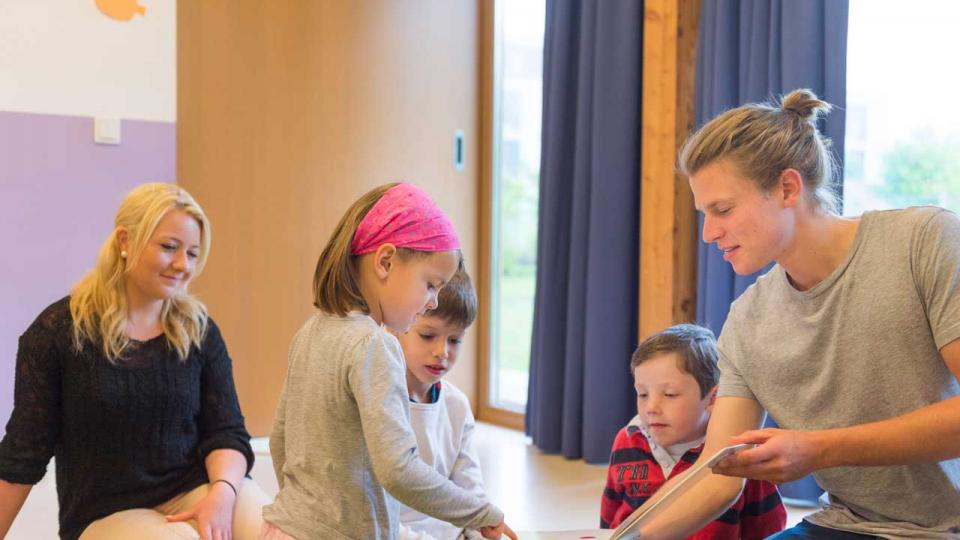
Language education integrated into everyday life
Promoting a language-stimulating environment
The family environment is the first and most important place for language acquisition. For the successful promotion of a child's language development, the exchange between parents and educational staff about ideas, knowledge and observations regarding the child's language acquisition is of crucial importance. Children have potential and abilities that need to be recognized, supported and further developed together.
The scientific findings and practical experience gained in recent years show that it is above all systematic language education integrated into everyday life that promotes children's language development. A language-stimulating environment in the day-to-day pedagogical routine of childcare offers many opportunities for this.Language education and observation methods
The state government's declared aim is to start language education as early as possible and to reach all children from the very beginning. Language education and observation should be integrated into everyday teaching. The selective language assessment with Delfin 4 has no longer been available for children in daycare centers since the 2014/2015 kindergarten year. It has been replaced by developmental and process-accompanying observation procedures.
In a joint process with the providers of childcare facilities, the state youth welfare offices and the scientific community, the state has developed the professional principles "Everyday integrated language education and observation in the elementary sector - principles for North Rhine-Westphalia". Language education based on quality criteria, the use of suitable observation methods and good training opportunities for educational professionals and teams at the facilities are intended to support practice.For developmental and process-accompanying observation in child daycare, educational professionals and providers have a choice of different methods. Taking into account the age group of the respective child, one of the following procedures is mandatory in everyday educational practice:Development and process-accompanying observation methods for language development
| Procedures for children under 3 years | Procedures for children from 3 to 6 |
|---|---|
Liseb 1 and 2: "Literacy- und Sprachentwicklung beobachten (bei Kleinkindern)" or BaSiK: Begleitende alltagsintegrierte Sprachentwicklungsbeobachtung in Kindertageseinrichtungen or DJI-Beobachtungsleitfaden: DJI - Die Sprache der Jüngsten entdecken & begleite | Sismik: Sprachverhalten und Interesse an Sprache bei Migrantenkindern in Kindertageseinrichtungen und Seldak: Language development and literacy in children growing up speaking German or BaSiK: Accompanying day-to-day integrated language development observation in childcare facilities |
Further information on BaSiK: www.bewegtesprache.de
Further information on the liseb, sismik and seldak procedures: www.ifp.bayern.de
Each childcare facility specifies a binding procedure for use in everyday pedagogical practice. The observation should be carried out and evaluated at intervals of no more than one year, or at shorter intervals if necessary. An information sheet with important information has been developed on how to use the available observation methods (Liseb 1 and 2, Sismik, Seldak, BaSiK):
Brochure "Everyday integrated language education in the elementary sector - basics for North Rhine-Westphalia"
You can find more detailed information on language education and observation as well as tips on implementation and design in the brochure "Alltagsintegrierte Sprachbildung im Elementarbereich - Grundlagen für Nordrhein-Westfalen", which you can download via the link below:
Note: The brochure is currently being updated due to the new legal regulations that have been in force since 01.08.2020. The contents on the implementation of language education, observation and documentation as well as qualification continue to apply.
Parents' flyer "Everyday integrated language education" Promoting children's language development:
Information for parents in 12 languages
The flyer for parents provides detailed information on the implementation of "Everyday integrated language education and observation" for children in daycare facilities.
The creation of a successful educational partnership between parents and educational staff in the daycare center is of great importance for the early support and promotion of the individual language development of each child. A flyer specifically informs parents about everyday integrated language education and observation for children in daycare centers.
The flyer "Everyday integrated language education and observation for children in daycare centers - information for parents" is available for download here in various languages. The flyers are not available in printed form. However, the flyer for parents in German is also available in A4 format for you to print out yourself in the brochure service.
Information flyer for childminders
Childminders are an important language role model in early childhood education, especially for children in the first years of life. This information flyer provides information on the language-promoting behavior of childminders and provides assistance for the application of language education strategies that demonstrably support children's language acquisition.
Information on the parent flyer "Everyday integrated language education" in simple language
The desire to offer a parent flyer on everyday integrated language education in simple language was often a suggestion from childcare practitioners. The aim is to reach as many parents as possible. The flyer in simple language is based on the rules for easy language.
Target group: Who is the flyer in simple language aimed at?- Parents with intellectual and other disabilities,
- Parents with learning difficulties or who have limited education and
- Parents whose first language is not German and whose language is not one of the translated languages of the flyer. The flyer in simple language is therefore also suitable for parents with limited knowledge of German
Rules of plain language:
Easy language as defined by the UN Convention on the Rights of Persons with Disabilities (UN CRPD) makes it easier for people to understand language content and texts. It therefore also serves accessibility.
Easy language follows certain rules and is characterized by
- short main clauses,
- largely dispensing with subordinate clauses,
- the use of familiar words, while difficult words are explained,
- the avoidance of technical terms, abbreviations and initials,
- a clear and large typeface without serifs,
- frequent paragraphs (a paragraph is created after every punctuation mark and for meaningful sentence sections),
- the separation of compound nouns by dots or hyphens.